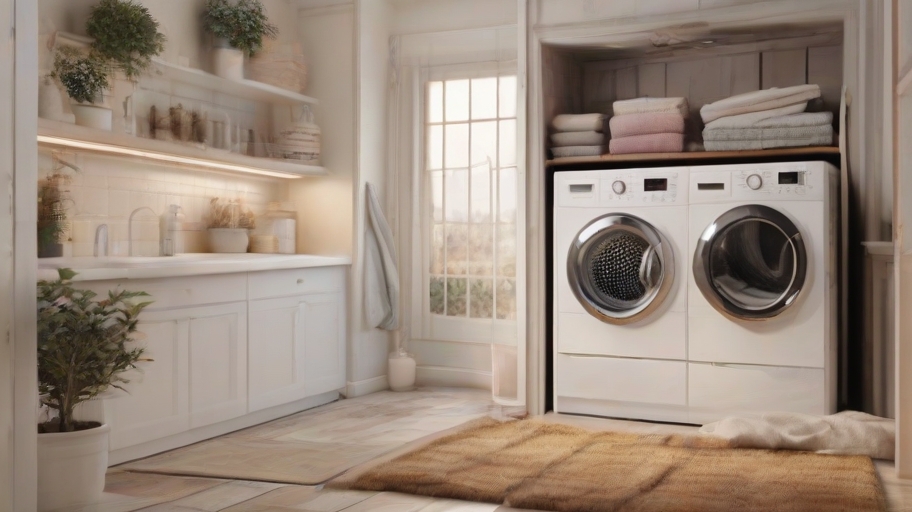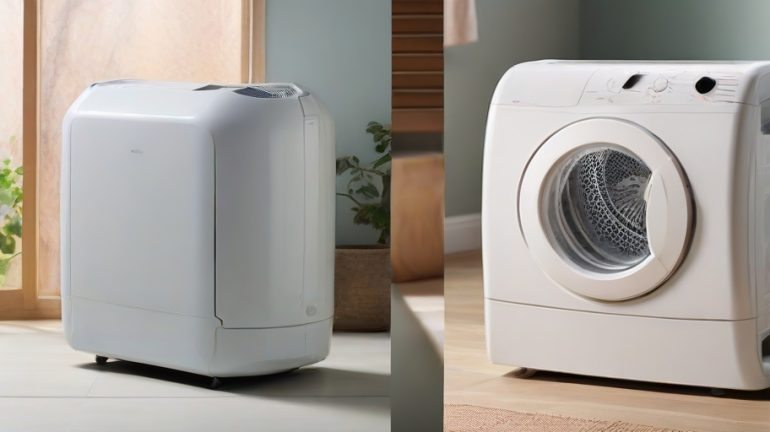When deciding how to dry your laundry, you might be torn between using a dehumidifier or a tumble dryer. Each has its pros and cons when it comes to drying clothes.
A clothes dryer works fast, giving you warm, dry clothes quickly. But it uses a lot of electricity, which can be expensive.
On the other hand, a dehumidifier is more energy-efficient and can help reduce the overall moisture in your home. It takes longer to dry laundry, but it can save you money on your energy bills in the long run.
So, you need to think about what’s more important to you: getting your laundry done quickly or saving energy and money over time. Your decision will impact how you manage humidity at home.
Choose what works best for you.
Dehumidifier vs Tumble Dryer
When you’re deciding how to dry your garments, you might think about using either a dehumidifier or a drying machine. A dehumidifier is kinder to your clothes and can save you money if you’re drying a lot of laundry at once, but it’s not as quick as a drying machine. On the other hand, a drying machine gets your clothes dry fast and is very easy to use, but it uses more electricity and might ruin your clothes faster.
Here’s why this matters: If you have the time to wait and want to save on your energy account, a dehumidifier is a smart choice. Plus, it’s better for your favourite shirts and pants because it’s less harsh. But if you need dry garments in a hurry or you are not too worried about energy use, a drying machine is the way to go.
For instance, imagine you have a big family and do laundry often. A dehumidifier could lower your monthly energy costs and keep clothes in good shape longer. Now, if you’re always on the go and need your work uniform or gym clothes dried ASAP, a drying machine is your friend.
Remembering to use these appliances properly also helps. For example, don’t overfill your drying machine—this can make it work harder and use more energy. And when using a dehumidifier, make sure the room is well-sealed to speed up the drying process.
In summary, both options have their perks. An appliance for moisture removal is more economical and gentle, while a heat tumbler is fast and convenient. Choose the one that fits your lifestyle and laundry habits best.
Advantages of Using a Dehumidifier for Drying Clothes

Using this appliance to dry your garments is a smart move. It uses less electricity, which saves you money, especially now that energy costs are going up.
Dehumidifiers are also better for your clothes. They dry them gently, which makes your clothes last longer.
Plus, dehumidifiers help keep your home healthy by lowering moisture. This stops problems like damp walls and mould from starting.
And because they take moisture out of the air, your clothes dry faster. This means no more waiting ages for clothes to dry and no need for a drying machine that can be harsh on your fabrics and expensive to use.
Drawbacks of Drying Garments via Dehumidifier
Using this appliance to dry your laundry might save energy, but it’s slower and needs more of your attention.
Time and Efficiency:
- Taking a long time: Clothes might take up to a full day to dry.
- Handling multiple loads: Not the best choice if you need to dry a lot of clothes quickly.
- Generates less heat: Clothes dry slower because it doesn’t get as hot as a regular heat tumbler.
Maintenance and Attention:
- Costs to run: Using it for a long time can make your electric bill higher.
- Keeping an eye on humidity: You have to watch the humidity levels to stop moisture build-up and mould.
- The good part: Despite these issues, it’s still good for saving energy and drying delicate clothes gently.
When you’re thinking about drying your clothes with a dehumidifier, consider the good and the bad. It’s slower and needs more monitoring, but it can be gentler on certain fabrics and use less energy.
Perks of Using a Tumble Dryer to Dry Clothes

Using a tumble dryer to dry clothes has a lot of benefits. Compared to using a dehumidifier, which takes longer, a tumble dryer works much faster and more effectively. You can choose from two main types of tumble dryers: vented tumble dryers or heat pumps condenser. Both types will dry a full load of laundry much quicker than if you just air-dried them.
Adding dryer balls to your tumble dryer is a great trick. They move around and help air flow better inside the drying unit, which cuts down on the time it takes to dry your clothes. This is especially helpful when you need your laundry done fast, like on busy days or if you suddenly realize you need clean clothes right away.
In short, a drying unit, especially with tumble dryer balls, is a time-saver for families or anyone who often needs to wash and dry laundry quickly.
Downsides of Tumble Drying Your Wardrobe
Employing a tumble dryer can harm your clothes and end up costing you more. Here’s why:
- Taking Care of Your Clothes: The intense heat from a drying unit can cause clothes to shrink or get damaged, especially if they’re delicate. Plus, if you keep using the drying unit, your clothes might start to wear out and fade faster.
- Energy Use and Expenses: Dryers use a lot of energy, more than air-drying or using a dehumidifier. Dryers with heat pumps can save you money over time, but they’re expensive to buy at first.
- Other Things to Think About: If you have a big family, the laundry drying machine might be too small to fit all your laundry. Also, using a drying unit can make your home more humid, which can lead to mould or a musty smell.
It’s good to remember that even though dryers can dry your clothes fast, they mightn’t be cheaper to run or for keeping your clothes in great shape. For example, instead of always using a laundry dryer, you could air-dry your garments or use a drying rack indoors, which is gentler on fabrics and can save you money on your energy account. If you do need a laundry drying machine, consider investing in an energy-efficient model to cut down on running costs.
Cost to Run: Which is Cheaper to Use?
When you compare the costs, it’s clear that running a dehumidifier is usually less expensive than a tumble dryer. This is particularly true when you don’t match it up against a heat pump tumble dryer, which is more energy-efficient.
For example, if you use a typical 250W dehumidifier, it’ll cost you about 0.07 pence for every hour it runs, assuming electricity is priced at 0.29p per kWh. That adds up to just over £0.56 a day and around £17.36 a month.
On the other hand, using a dryer for a year can cost you anywhere from £80 to £175, depending on the type you have and how energy-efficient it is.
So, while it might take a dehumidifier longer to dry your laundry, it can save you money on your energy bills.
It’s important to remember though, the main job of a dehumidifier is to cut down on moisture and prevent mould in your home, not just to dry clothes.
Deciding Your Match: Tumble Dryer vs Dehumidifier
Choosing the Right Appliance: Tumble Dryer or Dehumidifier?
If you’re trying to decide whether to buy a dehumidifier or a clothes dryer, think about what’s more important to you: saving money on energy, quickly drying your clothes, or having a versatile appliance.
- Dehumidifier and Tumble Dryer Comparison
- Saving Energy and Money A dehumidifier is usually less expensive to run than a tumble dryer, at about 8.5p per hour. Tumble dryers, particularly those with heat pump technology, use energy more efficiently in each cycle but tend to be more expensive when you first buy them.
- Speed and Ease of Use Tumble dryers work fast, which is great if you need to dry garments quickly. If you’re not in a hurry and prefer to save on costs over time, you can hang your garments on a clothes airer and use a dehumidifier.
- Flexibility and Use of Space Dehumidifiers can be moved around and used for reducing moisture in the air in different rooms, not just for drying clothes.
For example, if you live in a small apartment and are looking for something that can help with dampness as well as dry clothes, you might prefer a dehumidifier. But if you often find yourself needing dry clothes in a hurry, a drying machine might be the better choice for you. Remember, think about what’ll work best for your lifestyle and your home.
There you have it, dwellers– while the moisture device might not have the speed of a laundry drying machine, it compensates with a cocktail of benefits that can sweeten the deal for any cost-conscious, fabric-loving homeowner. So, next time you’re wrestling with a wet laundry load and eyeing your energy statement with a wince, why not consider the humble dehumidifier? Your wallet might just throw you a thank-you party!

